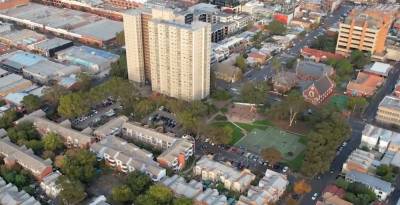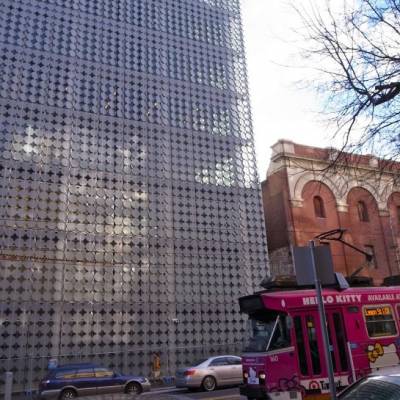home » news » cities » Australia » Victoria
Designing for the homeless
The question is what can design thinking do to contribute to averting homelessness, mitigating its effects and improving the daily life of those who are homeless and proposing different and longer term pathways to social inclusion, housing, and employment. [ Briefing for DRI 2011:Homelessness competition ]
Sean Godsell will be speaking at the briefing session tonight. In 2002 I interviewed Sean Godsell at his offices for an article about his homeless shelter – a modified park bench. I was positive about it, partly to try to counter-balance the negative coverage elsewhere. It was contentious then, as was the 2004 follow-up, a bus shelter that also accommodates a bed. Bit more obvious this one, as it was parked right in front of the NGV.
Godsell has continued producing prototypes attempting to provide homeless shelter solutions in public space, most recently last year in a London museum, and in July gave a lecture about them. The Age published an article at the time that restated the arguments for and against his work. The Sacred Heart Mission’s Michael Perusco wasn’t exactly for it:
‘‘I think that the main focus for government and community agencies should be on working with people to address the underlying causes of their homelessness and have a housing market that delivers affordable options… [These] types of initiatives distract from that.’‘
This echos criticism from Chris Middendorp (then at Hanover Welfare Services) in 2002, saying that a dollar invested in these schemes was a dollar lost to more permanent solutions. “If we accept Godsell’s Band-Aid measure, we’re saying that we have finally given up.” But he did accept that the coverage of the issue was not such a bad thing:
“Maybe Sean Godsell is playing the trickster and his park-bench scheme is really a cunning ruse to put affordable housing on the agenda. Perhaps it’s just an extraordinary gimmick designed not to shelter people, but to reinvigorate our social consciences and provoke a much-needed debate. That would be a valuable contribution.”
The sentiment seems to be that designing for homelessness is OK, as long as it’s not serious, because the money is better spent solving the underlying issues. I can’t argue with that, assuming there is just one pot of money. But Middendorp does discuss some negative impacts of design in another undated article.
In recent years, I’ve seen some outlandish ways of ‘managing’ homelessness. Seats are removed from footpaths where people congregate. Tram stops are physically altered to make them difficult to sleep in. Alcoves and lanes all over town are now sealed off by metal gates. Bushes are cut down to discourage people from sleeping under them. The authorities might argue that it’s all done to make Melbourne a safer place. Safer? For whom?
Godsell would agree on that point at least:
‘‘The conscious decision to construct and design to actively exclude transients or desperate people I find a distressing reflection on the state of society.”
It isn’t OK to design bumps into the seats at tram stops. But it also isn’t OK to alter tram stops so that they might provide better shelter and comfort for sleeping, as this would distract attention and money from the real problem. So we are stuck with the status quo. But without a voice insisting that the homeless are kept in mind in the design of public space, things will just get less-friendly… like, for example, in the U.S., or in Queensland.
Install benches or other types of seats for people can [sic] sit and observe activities on streets, sidewalks, open spaces, etc. Design the seats to comfortable [sic] for sitting and not for sleeping or skateboarding. [ San Diego Police Dept – deterring crime through design ]
The dominant view in recent years is that the use of public space has become increasingly restrictive, with a raft of regulations prohibiting certain acts, resulting in the criminalisation of the homeless. The logic underpinning these punitive regulations are to safeguard and protect the public from the predatory actions of those inhabiting public space, which in turn can cleanse city centres and attract capital. [ Homelessness and the Control of Public Space – Criminalising the Poor? PDF
Perhaps we could stop assuming that it is fine for tram and bus stops to be sponsored Adshells with seats drenched by any passing squall. If they could instead revert to being tram ‘shelters’, paid for by the Department of Transport, there would be no impact on available funds for the homeless. Perhaps street furniture design needs to be reconsidered so that it might still be of use, if needed, after hours.
Bus shelters are… a form of space intended for the majority. But they still provide shelter for homeless people – even if the people who designed and built them didn’t intend this… This shows that a social space can have different uses for a variety of social groups. So we must ask critical questions when a space is altered so that it excludes certain groups. [ Joshua Anderson ]
—- Found on my travels —-
The numbers
At the 2001 census, the number sleeping rough or in “improvised dwellings” in the Melbourne Statistical Division was 704 of a total homeless count of 14,072. In 2006 845 were counted. Zooming into the CBD area, including North and West Melbourne, about 100 people have been counted in recent annual surveys by the City of Melbourne.
Common Ground
Last Friday, on 7.30 Victoria, there was a news item on the first anniversary of Elizabeth Street’s Common Ground building. About 60 residents have their own flats in the building, built at-cost by Grocon, and its consultants and subcontractors. There is a need for another four of these buildings to to cater to 250 of Melbourne’s most chronically homeless, but the new state government has no plans for this.
EDAR
“Revenge of the Nerds” director Peter Samuelson, perhaps making up for past sins, is spearheading a campaign in California to improve the lot of those in cardboard housing. An estimated 5,000 are homeless in LA’s skid row. After talking to homeless people in Santa Monica, he asked himself, “What is there that’s better than a damp box on a rainy night even if it’s not as good as a bed?” The Art Center College of Design in Pasadena organised a competition for him and the EDAR (Everyone Deserves A Roof) was the result. A rather bulky shopping trolley that folds out into a tent, the EDAR can be used in a park, on the footpath, or within homeless shelters.
Posted by Peter on 08.09.11 in cities
tags: homelessness, sean godsell
comment
Commenting is closed for this article.



